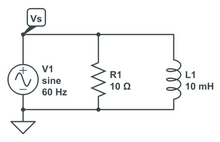Circuit Theory/Phasors/Examples/Example 9
Given that the voltage source is defined by , find all other voltages, currents and check power.

Label Loops Junctions
edit
In a parallel circuit, all devices have the exact same voltage across them.
Knowns, Unknowns and Equations
edit- Knowns:
- Unknowns:
- Equations:
Initial conditions
editSaying the initial conditions are zero is impossible in this problem.
Look at the terminal relation:
VS has a non-zero value at t=0+. This means . This one initial condition. The other initial condition is that i_L(0+) = 0.
Calculus Symbolic
editEvaluate the terminal relations in this order:
Calculus Numeric
editThe next step is to combine the answer into a single cos term with a phase shift so it can be compared to and . The -39 turns into a DC bias.
The easiest method to combine the sin and cos terms is phasors.
Here is the phasor method. Notice the math is done in the phasor domain ... with imaginary numbers.
Now the numbers are in the phasor world. The next step is to add them all up.
Now put back into the time domain:
Phasor Symbolic
edittime domain
editphasor domain
editback to time domain
editinvolved an integral in the phasor domain, thus a constant as been added to their time domain equation.
Phasor Numeric
editthere is no point in doing the math in the phasor domain if can solve in symbol form as above
time domain
editThese are the same numbers as calculated with Calculus above ...
Simulation
edit, , , and from the simulation simulation are graphed below.
| Symbol | color | Equation |
|---|---|---|
| Brown | ||
| Orange | ||
| Example | ||
| Vs</math> | Blue |
Simulation matches the math. Circuitlab simulation requires taking current into the source in order to get the phase right. This can be seen by testing circuitlab with a sinusoidal source across one resistor.
The simulation also shows that the integration constant is dependent upon the phase angle of the source.
period check
editThe period above looks to be between 16ms and 17ms, closer to 17ms. This agrees with the formula:
magnitude check
editThe simulation magnitudes, if measured peak to peak match the doubled magnitudes of the numeric answers. The integration constant adds a DC bias which is negative in this case.
phase check
editVoltage will always lead the current through an inductor (think of the terminal relationship or ELI) by or of a period, whether a current source or voltage source is driving the circuit.
Power Analysis
editThe constants are going to add some DC power or real power to this analysis. Without knowing what they are, we can not compute their impact. So for now we stick with phasor domain power analysis:
if : , and then
and
This is a bad power factor. The utility's apparent power is much larger than what the customer is willing to pay. Pure inductive loads as described are found in large motors in industrial settings where engineers working for industry are talking to engineers working for the power company. Power conditioners may be needed to bring this power factor back up closer to 1. The utility will charge based upon apparent power ... which is real $$$ for them.
| Value | Units | Description |
|---|---|---|
| volt-ampere va | apparent power what utility companies manage: peak power they design for, peak power they have to deliver | |
| unitless | power factor, ratio of real power to apparent power, ideally 1 | |
| watt W | real, average, active power ... what consumers want to pay for (watt-hours) | |
| volt-amp-reactive var | reactive power ... why not all outlets in a room are on the same circuit breaker |
Intuition
editELI ... voltage leads the current through an inductor
Integration constants matter. Initial conditions matter. Phasors don't deal with them.
A purely inductive load connected to a power source is going to create a bad power factor.
If integration constants show up, and there is no differential equation, must compute the integration constants using initial conditions.
Phase angle of the source influences the integration constant.
